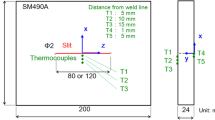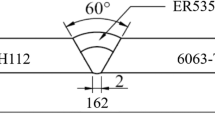Abstract
For predicting welding distortion and residual stress generated by laser-arc hybrid welding (HYBW) with high accuracy by the 3D thermal elastic-plastic analysis based on FEM, a heat input model considering the dual heat source of HYBW was proposed. By using the proposed model, welding distortion and residual stress generated by HYBW on the general structural steel under several welding conditions, in which the heat input ratio of laser and arc were variously changed, were obtained. Comparing with the results obtained by experiments and analyses, the validity and generality of the proposed heat input model could be verified. The tendency and magnitude of welding distortion varied with the heat input ratio of laser and arc. The results indicated the possibility for controlling welding distortion generated by HYBW with the optimum heat input ratio of laser and arc.
Similar content being viewed by others
Refrerences
Inose, K., Lee, J-Y., Nakanishi, Y., and Kim, Y-C. (2008). “Characteristics of welding distortion/residual stress generated by fillet welding with laser beam and verification of generality of its high accurate prediction.” Quarterly Journal of The Japan Welding Society, JWS, 26(1), pp. 61–66 (in Japanese).
Kim, Y-C., Hirohata, M., Mutyaba, G., and Inose, K. (2011a). “Fatigue characteristics of laser beam welded joints for high strength steel and their dominant factors.” Proc. National Symposium on Welding Mechanics and Design 2011, JWS, pp. 399–402 (in Japanese).
Kim, Y-C., Hirohata, M., and Inose, K. (2011b). Modeling of laser-arc hybrid welding considered phase transformation. Document of IIW 64th Annual Assembly, IIW, Doc. XV-1380-11.
Kim, Y-C., Lee, J-Y., and Inose, K. (2010). “Determination of dominant factors in high accuracy prediction of welding distortion.” Welding in the World, 54(7/8), pp. 234–240.
Kim, Y-C., Lee, J-Y., and Inose, K. (2007). “Dominant factors of high accurate prediction of distortion and residual stress generated by fillet welding.” International Journal of Steel Structures, 7(2), pp. 93–100.
Lee, J-Y., Inose, K., and Kim, Y-C. (2010). “Verification of validity and generality of dominant factors in high accuracy prediction of welding distortion.” Welding in the World, 54(9/10), R229–R235.
Author information
Authors and Affiliations
Corresponding author
Additional information
Joining and Welding Research Institute, Osaka University
Discussion open until November 1, 2014. This manuscript for this paper was submitted for review and possible publication on June 1, 2013; approved on March 5, 2014.
Rights and permissions
About this article
Cite this article
Kim, YC., Hirohata, M. & Inose, K. Verification of possibility for controlling welding distortion generated by laser-arc hybrid welding. Int J Steel Struct 14, 323–329 (2014). https://doi.org/10.1007/s13296-014-2012-2
Published:
Issue Date:
DOI: https://doi.org/10.1007/s13296-014-2012-2




